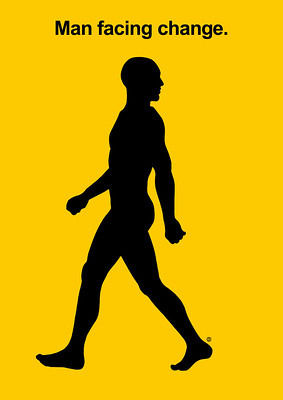|
|
|
Tuesday, March 24th, 2020

This is the post that I mentioned yesterday. As Wally points out so elegantly “do as I say and not as I do” doesn’t work anymore — if it ever did. (BTW, you might find this post on leadership as a profession of interest.)
“There is no leadership without leadership by example.” ~ Captain James Westley Ayers, USMC
Captain Ayers was right. There is no leadership without leadership by example. What he didn’t say is that example can be good or bad. You don’t get any choice about whether you lead by example, only about the kind of example you set.
Most writing about leadership by example assumes a good example. If you work hard, the people on your team will work hard, too. If you’re honest, they will be, too. It’s the way it is. It’s human nature.
Human nature has a baked-in capacity and desire for hierarchy. That’s why you must be careful. It’s easy to set a bad example.
People Are Watching
If you’re the person responsible for the performance of a group, the other members watch you. That’s because you have some power over them. It may not be much, but it’s there. They watch what you do as a guide to what they should do.
Everyone I know who’s been promoted in large organizations has some version of the same story. A leader does something without much thinking about it and people take it as a guide to behavior. The story I like best is the one told by Linda Hill about when she was promoted to President of General Dynamics.
She went shopping for a new suit to celebrate her promotion. The salesperson sold her a scarf with the suit and showed her an interesting way to tie the scarf. She wore the suit and the scarf, tied in that special way, her first day on the job. What happened, in Ms. Hill’s own words.
“And then I came back to work the next day and I ran into no fewer than a dozen women in the organization who have on scarves tied exactly like mine.”
Another friend tells about his first day on the job as plant manager. He made several casual comments about how they could move equipment to be more effective. The next day, when he went to the plant, he found that all his “ideas” had been implemented overnight.
Then, there was the friend who forgot to get his usual morning coffee on the way to the office on his first day in a new position. When he realized what he’d done, he said out loud to himself, in his office, “God, I wish I had some coffee.” Within minutes, three cups of coffee arrived.
Be careful what you do and what you say. People are watching.
Be Careful What You Praise
Praise is a power tool. You use it so that people will do things or keep doing things that you want them to do. We love praise. Just remember, people are listening.
You will get more of what you praise. If you praise great ideas, you will get more of them. If you praise courage, people are likely to be more courageous. But if you praise people who work long hours. other people will start putting in more time. If you praise people who answer email in the middle of the night, folks will start sleeping with their phone by the bed.
How Do You Act When Things Don’t Go Your Way?
Some things will not work the way you’d hoped. Some news will be bad news. How you act tells your team members some important things.
If you receive bad news gracefully and take it as information, people will be more likely to bring it. Even more, if you thank them for letting you know. People don’t mind being the messenger that gets praised for doing a good deed. They don’t want to be the messenger who gets killed.
When you’re interrupted it’s another opportunity to set a good example. Treat the people who interrupt you with respect and courtesy. Then, if the interruption is inappropriate, tell them why.
What You Tolerate, You Condone
It’s hard to do, but you need to address behavior or performance that violates your standards or values.
Mark Deterding tells a story from early in his career. Mark was in his mid-twenties, when he was transferred and promoted to plant manager. During his first few meetings, he was struck by the amount of swearing by the seasoned veterans on his team.
He decided he would just model the right way and his team members would change. But it didn’t work that way. They went right on swearing. Here’s the lesson Mark said he learned.
“It’s not enough to just model the way. It’s just as important to clearly and immediately address any issues that violate the values of the organization. When you allow unacceptable behaviors to go unaddressed, you send the message that the behavior is okay.”
Bottom Line
When you lead by example, you use your behavior to influence the behavior and performance of team members. Your influence is a leadership superpower. And, like any superpower, you can use it for good or for evil. What’s your choice?
Image credit: Wally Bock
Posted in Culture, Leadership, Personal Growth | No Comments »
Wednesday, March 11th, 2020

As we saw yesterday, business is learning the hard way that walking their corporate responsibility talk is vital to their very survival.
They aren’t the only ones out of touch.
John C. Williams, the president of the Federal Reserve Bank of New York, said in a speech last month that “there is still time to avert this fate.” Moving inflation up and keeping it there could convince millennials, he said.
“In this case, it’s fortunate that the young are impressionable.”
“Fate” refers to the potential economic mayhem that could result from the high savings rate among Millennials looking to retire ASAP. “Impressionable?” I wonder how long it’s been since he actually knew any of the “young.”
Powerful men who have seen women as things to do with as they please are thinking twice in the wake of #metoo and Harvey Weinstein’s conviction. Hopefully that caution will trickle down to the rank and file bosses who still seem untouchable, although that’s unlikely.
Big Tech is no longer seen a solution to the world’s problems, but, in many cases, as their cause.
Startups are learning that public investors, whether knowledgeable or casual, are still hung up on mundane ideas like profit as opposed to their beloved EBITDA.
Founders, too, are rethinking their actions. Thanks to high profile cases, such as Travis Kalanick (Uber) and Adam Neumann (WeWork), and a much savvier workforce, visions and charisma are no longer enough.
One might look at all this and say, “the world is changing,” although a more realistic view could be summed up as “too little, too late.”
Image credit: CHRISTOPHER DOMBRES
Posted in Communication, Culture, Personal Growth, Politics | No Comments »
Tuesday, May 14th, 2019

I used the following quote in a post about ego taking over startup founders.
Star CEOs grow dangerous when they see their success as destiny, their place at the head of the pack as the only path possible, rendering all of their choices justified.— Zachary First, managing director of The Drucker Institute (A 2013 Fortune article, link dead))
Obviously, it’s not only founders, but, just five years later, would you expect it to apply to so-called progressive managers?
It does, with a vengeance.
The (unfortunately) best (worst?) example comes from the Southern Poverty Law Center.
The most egregious recent example of this troubling type appears to exist in Morris Dees, 82, co-founder and the powerful former head of the Southern Poverty Law Center (SPLC) in Montgomery, Alabama. He was removed from that post in March, following allegations of workplace misconduct. Specifically, the leader of the SPLC, known for its doggedness identifying and winning court cases against vile hate groups, was accused of racism and multiple counts of sexual harassment.
Dees’ fall shocked everyone, except the people who had worked closely with him, according to a recent New Yorker essay by journalist Bob Moser, who worked at the SPLC for a few years in the early 2000s. The organization known as a “beacon of justice” as he writes, was in fact what another one of its former writers called a “virtual buffet of injustices.” Employees worked within a two-tiered system: People of color were hired for support roles, while the higher-paid leaders, lawyers, writers, and fundraisers were “almost exclusively white.”
None of us like our heroes to have feet of clay, but it is easy to start seeing through an “I’m doing good in my world, therefore I am good and can do no wrong.”
In other words, if I’m fighting them, I’m not acting like them and shouldn’t be compared to them.
Years ago someone my crowd thought of as a good friend stole my credit card and jewelry and another guy’s car, etc. When he was caught he told the judge that, since he had done good for us, his stealing was no big deal.
Doing good is not a vaccine.
I recently wrote about the importance of objectively; using it on yourself can help you avoid the “do as I say, not as I do” trap.
Weekly, take a hard, look at your own actions and compare them objectively to someone on the philosophically opposite side.
Any similarities should serve as a warning.
Do something about them immediately.
Image credit: Anders Sandberg
Posted in Culture, Ethics, Personal Growth | No Comments »
Wednesday, February 6th, 2019

One of the major reasons people ghost isn’t rocket science.
Nor is the major cause.
Candidates ghost because nothing connected — not the company, culture, job, people, and especially not the hiring manager.
Employees ghost because they aren’t engaged.
They feel that nobody — boss, company, colleagues — gives a damn so why should they.
And in many cases they are correct.
Companies don’t walk their cultural talk, low morale is obvious, as is a “me before thee” attitude, and
for a variety of reasons, bosses treat people as replaceable — even when they know it won’t be easy or could take months.
It’s nothing new.
Since the day people became hires, instead of slaves or indentured, bosses have used and abused them.
They still do, but on a more refined level.
Skipped promotions, demotions with little-to-no explanation, seriously brutal layoffs by email, with no warning (as Elon Musk just did), which is especially destructive to people when the company/job has been cast as some kind of “higher calling,” as is common in the tech world.
Candidates often fare no better.
Many managers consider hiring a necessary evil — resumes bore them, they hate wasting time interviewing — and they have more important things to do.
Strangely enough, HR often acts the same way, with preliminary interviews conducted by interviewers who look for word matches between resumes/candidates and job descriptions.
Obviously, it’s not all companies or all bosses — but likely the ones that get ghosted.
Image credit: Joe Le Merou
Posted in Communication, Culture, Hiring, Motivation, Retention | No Comments »
Friday, December 7th, 2018
 (click to enlarge) A Friday series exploring Startups and the people who make them go. Read all If the Shoe Fits posts here.
Bias is in our heads. Bias is in our MAP (mindset, attitude, philosophy™).
Bias totally permeates us and the rest of society.
It’s embedded in our schools, our religions and all forms of AI.
Experts, educators, gurus, and pundits analyze it, write about it, consult about it, and coach on it.
And often contradict each other.
If bias is this pervasive, the experts so ineffectual and management so ambivalent, what can one person do on their own?
You can access your MAP (mindset, attitude, philosophy™) where bias lives.
No one else can, only you.
That means you can change your MAP.
No one else can, only you.
One bias at a time.
Image credit: School of Thought
Posted in Personal Growth | No Comments »
Friday, October 6th, 2017
A Friday series exploring Startups and the people who make them go. Read all If the Shoe Fits posts here.
 Ask most tech founders about role models and who they want to emulate and you’ll usually hear the same names — Gates/Jobs/Page/Zukerberg/Bezos. Ask most tech founders about role models and who they want to emulate and you’ll usually hear the same names — Gates/Jobs/Page/Zukerberg/Bezos.
Rarely do you hear Benioff.
Granted, Benioff’s Salesforce’s revenues aren’t as high and the valuation is “only” $66 billion, but Salesforce sells no consumer products — ads are products — therefore has a much smaller market.
Revenues aside, Benioff is a much better leader and role model.
Not just a philanthropist, but an activist philanthropist who is not afraid to use his clout and get in the face of his peers.
Given the same clout, would you do the same thing?
A guy who believes a company’s concerns should go beyond its investors to include all its stakeholders, direct and indirect.
How far beyond yourself do your concerns go?
Tech’s been on the hot seat lately for a host of reasons, with gender issues front and center, especially equal pay.
Most, including the “role models” listed above, have been vocal in their promises to address the pay disparity.
Benioff, however, has put his money where their mouths are.
In 2015, his company did a salary study, and it turned out they needed to make some changes. So they spent $3M to level the playing field. A year later, they put salaries under the microscope again and found they had to spend another $3M to close additional pay gaps.
Now Benioff has pledged to evaluate salaries on a regular basis. For this and more, he was named a “Global Champion of Women in Business.”
And before you whine about not having enough cash to do that stop and think.
If you pay your people equally when you hire and promote there wouldn’t be a pay gap for you to erase.
Image credit: HikingArtist
Posted in Culture, If the Shoe Fits, Personal Growth, Role Models | No Comments »
Friday, October 21st, 2016
A Friday series exploring Startups and the people who make them go. Read all If the Shoe Fits posts here.
 I’ve been talking, a lot in the last few weeks about the importance of values. I’ve been talking, a lot in the last few weeks about the importance of values.
And more importantly, why/how they need to be embedded in your company’s culture to protect it as you grow.
Not just my thoughts, but links to business leaders and entrepreneurs who say the same thing.
The problem, of course, is that talk is fast and easy, while execution takes time and effort.
And that’s the reason the result often looks like this.

Image credit: HikingArtist and Thomson Reuters via CB Insights
Posted in Culture, If the Shoe Fits | No Comments »
Tuesday, August 30th, 2016

I am not a lover of trendy terms, no matter how hilarious Dilbert makes them, and I’ve found they turn off a lot of people — from workers to bosses.
One of the newest to hit the trendy list is “agile” in all its various forms.
What became trendy agile was born 15 years ago.
The term originated in the Manifesto for Agile Software Development in 2001. It was a specific approach in a specific sector, but soon its core principles – moving quickly to build a minimum viable product, using iterative development to improve it on the go, with testing and feedback built in at every stage rather than just at the end.
Just how ubiquitous has agile become? It was used by Walmart CEO Doug McMillon last fall in a memo to employees to describe the future (and justify layoffs).
“Our customers are changing. Retail is changing and we must change,” McMillon wrote in the memo obtained by The Associated Press. “We need to become a more agile company that can easily adapt to shifting customer demand.”
Many companies talk about becoming agile and a large number of them think a quick and easy means to that end is to lay off the older and bring in the younger.
They couldn’t me more wrong. It’s not age that makes one agile, Salesforce CEO Mark Benioff isn’t young, it’s MAP.
Your MAP is responsible for how you lead, as well as the values that underpin your company’s culture.
If your MAP isn’t agile, or willing to change to become so, there is little hope that your company (or department or team) will be agile.
Hat tip to Wally Bock for pointing me to this article.
Flickr image credit: Martin Pool
Posted in Culture, Ducks In A Row, Innovation | No Comments »
Wednesday, March 30th, 2016

Gen. George S. Patton, who commanded the US’s 7th Army in Europe and the Mediterranean during World War II, is one of the most loved and respected soldiers in US history.
Patton was tough, irascible, inspiring and considered a guru on the subject of leadership.
After reading a list of brilliant, succinct, one-liners on leadership, taken from the 1995 book “Patton’s One-Minute Messages” by Charles M. Province, I picked seven to share, with appropriate (if sometimes irreverent) commentary.
“No good decision was ever made in a swivel chair.” Even if it’s a Herman Miller design, so get up, get out and walk around.
- “Do everything you ask of those you command.” Especially since no boss does a lot of commanding these days.
- “No one is thinking if everyone is thinking alike.” The only thing that may benefit from hiring yes-people is your ego and that’s only in the very short-term.
- “Never make a decision too early or too late.” That said, worst of all is no decision at all.
- “Know what you know, and know what you don’t know.” Now learn to admit it.
- “Success is how you bounce on the bottom.” I can personally swear to the accuracy of this having bounced several times in my life.
- “Any man who thinks he’s indispensable, ain’t.” This is my all-time favorite. It’s similar to one my first boss used when a team member got a little too cocky, “Nobody can be duplicated, but anybody can be replaced.”
You can learn a lot from Patton as long as you remember that he was a great leader not because of his skill for soundbites, but because he always walked his talk.
Image credit: National Archives
Posted in Leadership, Personal Growth | No Comments »
Tuesday, December 15th, 2015

There’s a lot of talk out there about the best ways to engage your people, with the dual goals of juicing creativity and innovation and hiking productivity.
As founder and CEO of Quarrio, I spend a lot of energy and time building and sustaining a culture that fosters an environment in which our people flourish.
I believe that is what produces the desired engagement results.
That is why we don’t give a damn about gender, age or alma mater; even skills and experience take a backseat to attitude when we hire.
My whole team, not just senior staff, talk about this frequently.
Recently one them shared this internet meme as a mathematical view of what we all believe.
And since it’s the time for gifts and sharing, I thought I would share it as my holiday gift to you.
This comes from 2 math teachers with a combined total of 70 yrs. experience.
What Makes 100% ?
What does it mean to give MORE than 100%?
Ever wonder about those people who say they are giving more than 100%? We have
all been to those meetings where someone wants you to give over 100%.
How about achieving 103%?
What makes up 100% in life?
Here’s a little mathematical formula that might help you answer these questions:
If:
A B C D E F G H I J K L M N O P Q R S T U V W X Y Z
Is represented as:
1 2 3 4 5 6 7 8 9 10 11 12 13 14 15 16 17 18 19 20 21 22 23 24 25 26.
Then:
H-A-R-D-W-O-R-K
8+1+18+4+23+15+18+11 = 98%
And
K-N-O-W-L-E-D-G-E
11+14+15+23+12+5+4+7+5 = 96%
But,
A-T-T-I-T-U-D-E
1+20+20+9+20+21+4+5 = 100%
And,
B-U-L-L-S-H-I-T
2+21+12+12+19+8+9+20 = 103%
And look how far ass kissing will take you.
A-S-S-K-I-S-S-I-N-G
1+19+19+11+9+19+19+9+14+7 = 118%
So, one can conclude with mathematical certainty, that while Hard Work and
Knowledge will get you close, and Attitude will get you there.
It’s the Bullshit and Ass Kissing that will put you over the top.
Now you know why some people are where they are!
I wish you a wonderful holiday season filled 100% with joy, family, friends, colleagues and great food.
Posted in Communication, Culture, Personal Growth | No Comments »
|
 Subscribe to
Subscribe to
MAPping Company Success
About Miki 
Clarify your exec summary, website, etc.
Have a quick question or just want to chat? Feel free to write or call me at 360.335.8054
The 12 Ingredients of a Fillable Req
CheatSheet for InterviewERS
CheatSheet for InterviewEEs™
Give your mind a rest. Here are 4 quick ways to get rid of kinks, break a logjam or juice your creativity!
Creative mousing
Bubblewrap!
Animal innovation
Brain teaser
The latest disaster is here at home; donate to the East Coast recovery efforts now!
Text REDCROSS to 90999 to make a $10 donation or call 00.733.2767. $10 really really does make a difference and you'll never miss it.
And always donate what you can whenever you can
The following accept cash and in-kind donations: Doctors Without Borders, UNICEF, Red Cross, World Food Program, Save the Children
*/
?>About Miki
About KG
Clarify your exec summary, website, marketing collateral, etc.
Have a question or just want to chat @ no cost? Feel free to write
Download useful assistance now.
Entrepreneurs face difficulties that are hard for most people to imagine, let alone understand. You can find anonymous help and connections that do understand at 7 cups of tea.
Crises never end.
$10 really does make a difference and you’ll never miss it,
while $10 a month has exponential power.
Always donate what you can whenever you can.
The following accept cash and in-kind donations:
|









 Ask most tech founders about role models and who they want to emulate and you’ll usually hear the same names — Gates/Jobs/Page/Zukerberg/Bezos.
Ask most tech founders about role models and who they want to emulate and you’ll usually hear the same names — Gates/Jobs/Page/Zukerberg/Bezos.




